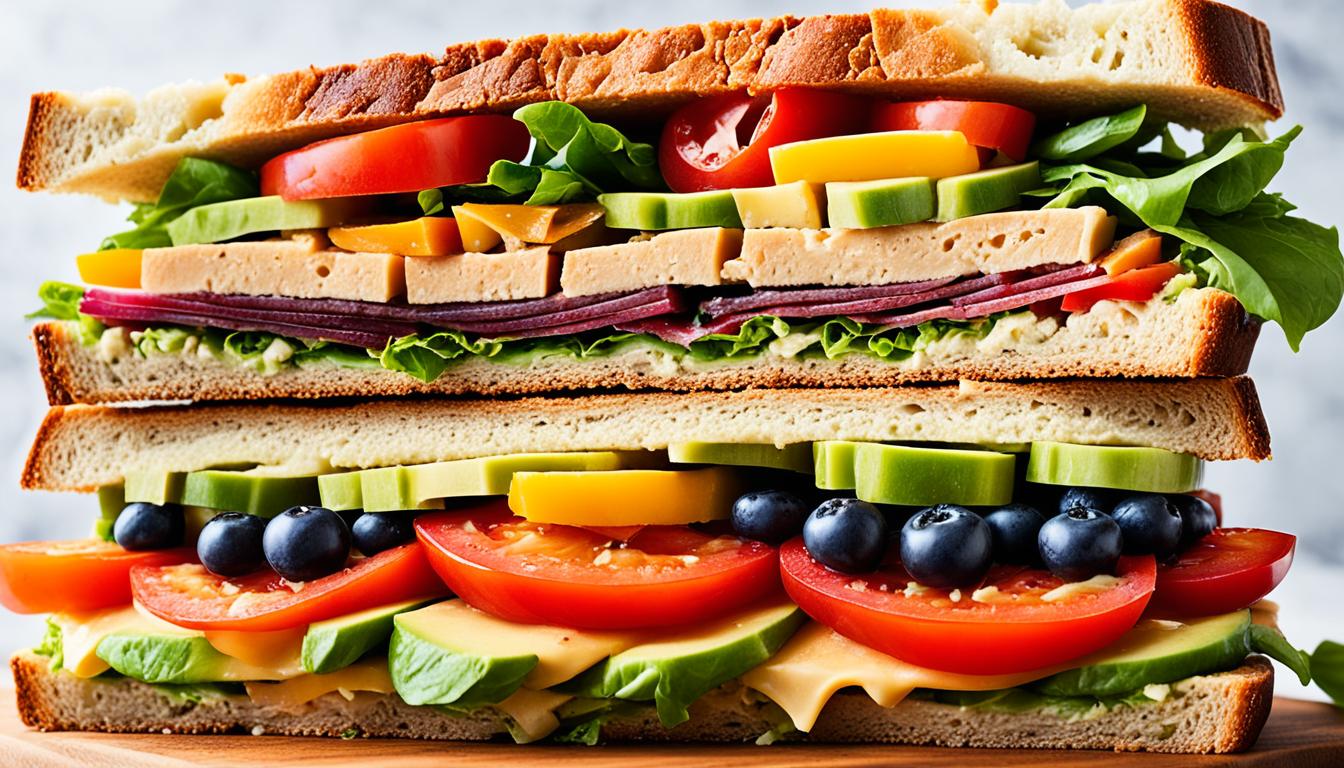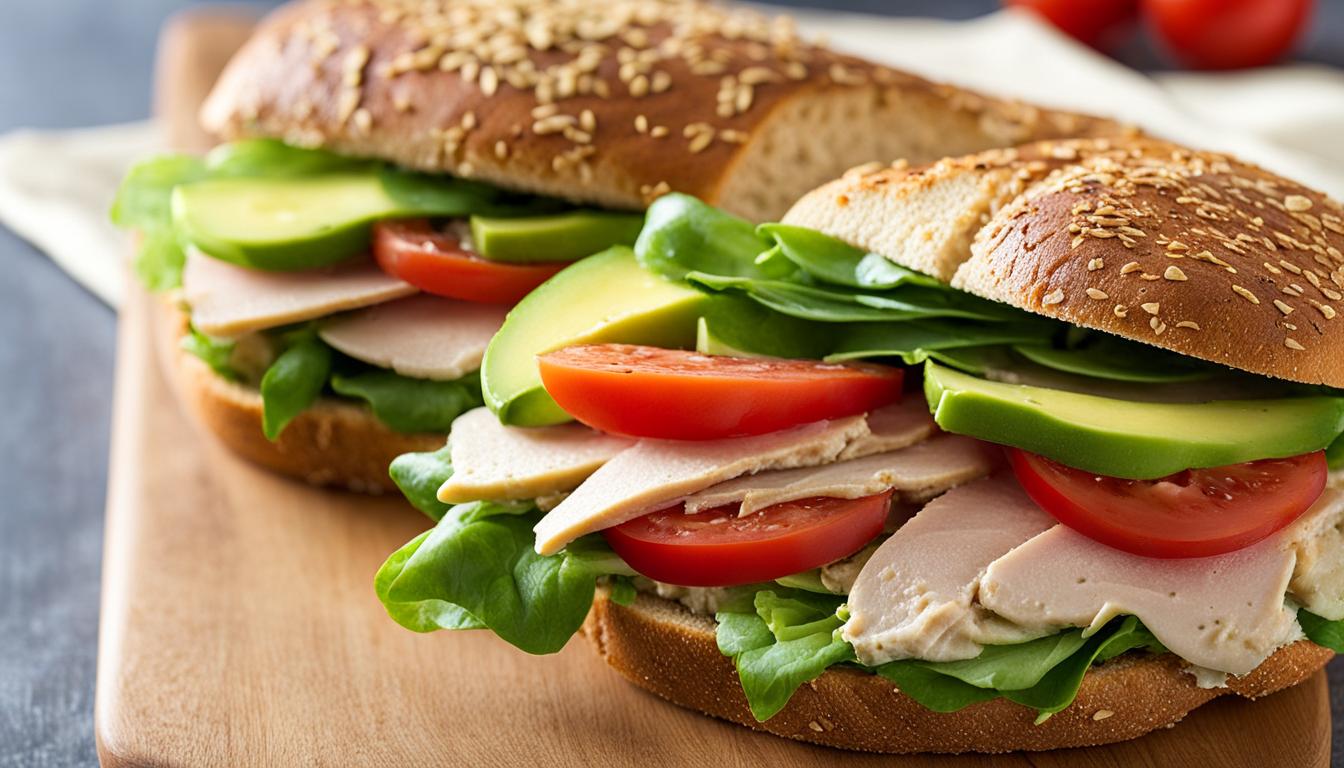Are you looking for a delicious and nutritious lunch option? Look no further than the in good health sandwich! This wholesome and flavorful meal is packed with nutrients while being low in calories. Whether you’re trying to eat healthier or simply looking for a tasty sandwich recipe, we’ve got you covered. Let’s dive into the world of healthy sandwich options and explore how you can create a sandwich that nourishes your body and tantalizes your taste buds.
One of the key elements of an in good health sandwich is the inclusion of fresh fruits and vegetables. These colorful and nutrient-rich ingredients not only add flavor but also contribute to your overall wellness. From crisp cucumbers to juicy tomatoes, you can choose from a wide variety of toppings that suit your preferences. By loading your sandwich with these fresh ingredients, you’ll not only enhance the taste but also boost its nutritional value.
When it comes to the fillings, lean proteins are the way to go. Chicken, fish, turkey, or even plant-based options like peanut butter or almond butter are excellent choices. These protein-packed ingredients will keep you feeling satisfied and energized throughout the day. By opting for lean proteins, you can ensure that your sandwich is hearty and nutritious without adding unnecessary fat or calories.
Another essential component of a healthy sandwich is the choice of bread. Swap out your regular white bread for whole-wheat bread. Whole-wheat bread is higher in fiber and nutrients, making it a healthier option. Not only will it keep you full for longer, but it can also help regulate blood sugar levels and improve cholesterol levels. So go ahead and make the switch to whole-wheat bread for a truly wholesome sandwich experience.
While we focus on what to include in a healthy sandwich, it’s equally important to be mindful of what to avoid. Cold cuts and processed cheese are high in fat, sodium, and preservatives. Opt for fresh slices of cooked chicken or turkey and genuine cheese instead. Another ingredient to avoid is white bread, which lacks the same nutritional value as whole-wheat bread. By making these simple swaps, you can transform your sandwich into a low-calorie option that doesn’t compromise on taste.
Creating a healthy sandwich is as simple as following a few guidelines. Load it with fruits and vegetables, choose lean proteins, opt for whole-wheat bread, be mindful of ingredients to avoid, and avoid prepackaged sandwiches. By making these small adjustments, you can enjoy a tasty and nutritious sandwich that contributes to your overall wellness. So go ahead and get creative with your healthy sandwich creations and enjoy a meal that not only tantalizes your taste buds but also fuels your body with essential nutrients.
Key Takeaways:
- Load your sandwich with fresh fruits and vegetables for added flavor and nutrition.
- Choose lean proteins like chicken, fish, turkey, or plant-based options to keep your sandwich hearty and nutritious.
- Opt for whole-wheat bread over white bread for increased fiber and nutrients.
- Avoid ingredients like cold cuts, processed cheese, and prepackaged sandwiches to reduce excess fat and sodium.
- Get creative with your toppings and fillings to make your healthy sandwich unique and delicious.
Load it with Fruits and Vegetables
In order to create a truly healthy and nutritious sandwich, it’s important to load it up with a variety of fresh fruits and vegetables. Not only do they add delicious flavor, but they also provide essential nutrients that promote good health and well-being. By incorporating a colorful array of produce, you can transform your sandwich into a wholesome and satisfying meal.

When it comes to adding fruits and vegetables to your sandwich, the possibilities are endless. Experiment with different combinations to find your favorite flavors. Consider adding slices of crunchy cucumber, juicy tomato, and zesty zucchini. For added texture and taste, try incorporating water chestnuts or any other vegetables that you enjoy.
Fruits can also be a delightful addition to your sandwich. For a refreshing crunch, try slices of cantaloupe, watermelon, and pears. Apples can add a sweet and tangy flavor that pairs well with various fillings. These fruits not only add a burst of flavor to your sandwich but also infuse it with vital nutrients and antioxidants.
Classic sandwich toppings like crisp lettuce, fresh onions, tangy pickles, and flavorful peppers can elevate the taste of your sandwich while adding essential vitamins and minerals. These toppings provide additional flavor, texture, and nutritional value that contribute to a well-rounded and healthy meal.
If you prefer a hot sandwich or you’re looking for toppings with less crunch, consider adding creamy avocados, cooked peppers, savory mushrooms, onions, or nutrient-rich spinach. These options offer a perfect balance of taste, texture, and nutritional benefits.
Choose Lean Protein
Protein is an essential component of a healthy sandwich. Opt for lean and unprocessed sources of protein to keep your sandwich nutritious. Choose sliced chicken, fish, turkey, or even canned tuna or salmon as healthy protein options. Plant-based eaters can choose natural peanut or almond butter as a protein source. By choosing lean proteins, you can avoid excess fat and calories while still satisfying your hunger and fueling your body.

Add a protein punch
When it comes to creating a hearty and nutritious sandwich, incorporating lean protein is the key. Whether you prefer meat, fish, or plant-based options, there are plenty of choices to suit your taste. Sliced chicken, fish fillets, and turkey breast offer lean protein sources that are packed with nutrients. If you enjoy seafood, canned tuna or salmon can be great options. For those following a plant-based diet, natural peanut or almond butter can provide a protein-packed punch. A sandwich with lean protein not only keeps you satisfied but also helps in muscle repair and growth, making it a wholesome choice for your midday meal.
Remember to choose unprocessed and low-fat versions of your protein options to keep your sandwich in good health. Skip processed meats and opt for fresh or cooked varieties. Whether you prefer savory or sweet, there’s a lean protein option that suits your taste buds.
Creativity in Your Sandwich: To add a burst of flavor and nutritious goodness to your meal, add some sliced avocado, tomato, or cucumber to your protein-packed sandwich. These toppings not only enhance the taste but also provide additional vitamins, minerals, and fiber, making your sandwich a wholesome and satisfying choice.
Opt for Whole-Wheat Bread
The type of bread you choose for your sandwich can make a big difference in its nutritional value. Opt for whole-wheat bread instead of refined white bread to increase your intake of fiber and nutrients. Whole-wheat bread is more filling and can help regulate blood sugar levels and improve cholesterol levels. By choosing whole-wheat bread, you can enjoy a nutritious sandwich that is lower in calories and higher in nutrients.

Whole-wheat bread is a healthier option because it is made from whole grains that retain more nutrients compared to refined white bread. It contains the bran, germ, and endosperm of the wheat, providing a good source of fiber, vitamins, and minerals. The presence of fiber in whole-wheat bread helps you feel fuller for longer, preventing overeating and aiding weight management. Additionally, the slow release of carbohydrates from whole-wheat bread helps regulate blood sugar levels, making it a suitable choice for individuals with diabetes or those aiming to maintain stable energy levels throughout the day.
Furthermore, whole-wheat bread is a nutritious choice due to its higher content of essential nutrients. It contains B vitamins, such as thiamin, niacin, and folate, which are important for energy production, brain function, and fetal development. Whole-wheat bread also contains minerals like magnesium, iron, and zinc, which play crucial roles in various bodily functions, including bone health, immune system function, and oxygen transport in the blood.
When selecting whole-wheat bread, it’s important to read the labels carefully. Look for products labeled “100% whole wheat” rather than “made with whole grains” or “multigrain,” as these may still contain refined grains. To add variety to your sandwiches and boost the nutritional content even further, consider options like whole-wheat pita bread, whole-grain wraps, or sprouted grain bread. These alternatives offer different textures and flavors while still providing the benefits of whole grains.
By making the simple switch to whole-wheat bread, you can elevate the healthiness of your sandwiches without sacrificing taste or satisfaction. It’s a small change that can have a big impact on your overall well-being.
Be Mindful of Ingredients to Avoid
In order to maintain a healthy and nutritious sandwich, it is important to be mindful of certain ingredients to avoid. By making smart choices, you can create a low calorie sandwich that is packed with nutrients and contributes to your overall well-being.
Cold cuts, although commonly used in sandwiches, are often high in fat, sodium, and preservatives. Instead, opt for fresh slices of cooked chicken or turkey as a leaner and healthier alternative. These options provide the protein you need without the excess calories and unhealthy additives.
Cheese is another ingredient that can add unnecessary calories and fat to your sandwich. Instead of choosing cheese products, opt for genuine cheese like bleu cheese or feta for added flavor. These varieties pack a punch in terms of taste while offering a healthier option for your sandwich.
Avoid using white bread, as it lacks the fiber and nutrients found in whole-wheat or other whole-grain bread options. By choosing whole-wheat bread, you increase the nutritional value of your sandwich and ensure that you are getting the necessary nutrients your body needs.
When it comes to grilled sandwiches, be cautious as they often contain excess oils or butter. While grilling can add flavor, it is important to keep an eye on the added fats that can sneak into your sandwich. Opt for healthier cooking methods or use minimal amounts of oil or butter to keep your sandwich as healthy as possible.
Lastly, it is best to avoid prepackaged sandwiches. These often contain low-quality ingredients and lack sufficient vegetables. By preparing your own sandwich, you can control the ingredients and ensure that you are choosing wholesome options that align with your health goals.
By being mindful of these ingredients to avoid, you can create a healthy sandwich that is low in calories and packed with essential nutrients. Your sandwich can be a delicious and nutritious meal choice that contributes to your overall wellness.

Conclusion
Creating a healthy sandwich is as simple as following a few guidelines. Load your sandwich with fruits and vegetables to add flavor and important nutrients. Choose lean proteins like chicken, fish, or turkey, or opt for plant-based options such as peanut butter or almond butter. Opt for whole-wheat bread to increase your fiber and nutrient intake. Be mindful of ingredients to avoid, such as excess fats and sodium found in cold cuts and processed cheese. Lastly, steer clear of prepackaged sandwiches that often lack quality ingredients.
By making these small adjustments, you can enjoy a tasty and nutritious sandwich that contributes to your overall wellness. With a wide range of healthy sandwich fillings, toppings, and spreads available, you can customize your sandwich to fit your preferences and dietary needs. Whether you’re looking for a low-calorie option or a sandwich packed with essential nutrients, the possibilities are endless. So go ahead and get creative with your healthy sandwich creations, and fuel your body with a wholesome and delicious meal.
FAQ
What can I add to my sandwich to make it healthier?
To make your sandwich healthier, load it with fruits and vegetables. Add slices of cucumbers, tomatoes, lettuce, and other favorite vegetables. You can also incorporate fruits like cantaloupe, watermelon, pears, and apples. Classic toppings like lettuce, onions, pickles, and fresh peppers also provide added flavor and nutrition. For those who prefer hot sandwiches or less-crunchy toppings, options like avocados, cooked peppers, mushrooms, onions, and spinach can be great choices.
What are some healthy protein options for my sandwich?
Lean proteins are an essential component of a healthy sandwich. Opt for sliced chicken, fish, turkey, or even canned tuna or salmon. If you follow a plant-based diet, natural peanut or almond butter can be a great source of protein for your sandwich. Choosing lean proteins helps avoid excess fat and calories while still satisfying your hunger and fueling your body.
What kind of bread should I choose for a healthier sandwich?
For a healthier sandwich, opt for whole-wheat bread instead of refined white bread. Whole-wheat bread is higher in fiber and nutrients, making it more filling and better for blood sugar and cholesterol levels. By choosing whole-wheat bread, you can enjoy a sandwich that is lower in calories and higher in nutrients.
What ingredients should I avoid to keep my sandwich healthy?
To keep your sandwich healthy, it is best to avoid certain ingredients. Cold cuts, like deli meats, are often high in fat, sodium, and preservatives. Instead, choose fresh slices of cooked chicken or turkey for a leaner alternative. Cheese can also add unnecessary calories and fat to your sandwich. Opt for genuine cheese rather than cheese products, and choose options like bleu cheese or feta for more flavor. Additionally, avoid white bread and choose whole-wheat or other whole-grain bread options. Be cautious with grilled sandwiches, as they often contain excess oils or butter. Lastly, avoid prepackaged sandwiches, as they are often made with low-quality ingredients and lack sufficient vegetables.
Source Links
- https://www.everydayhealth.com/healthy-recipes/healthy-sandwich-dos-and-donts.aspx
- https://www.eatingwell.com/gallery/8026324/healthy-sandwich-recipes-to-pack-for-work/
- https://leaf.nutrisystem.com/healthy-sandwich-tips/


